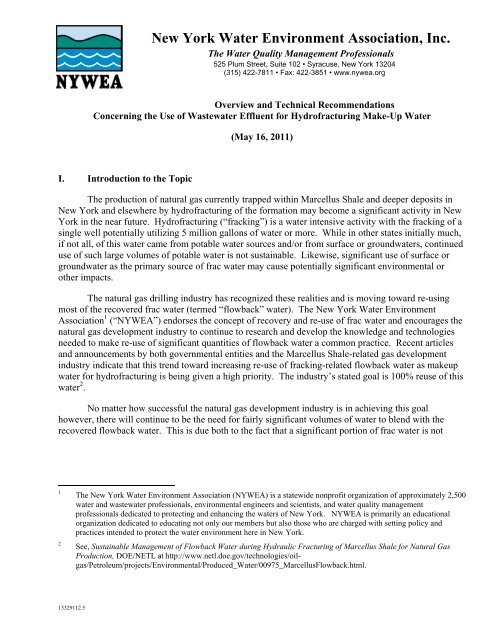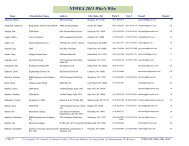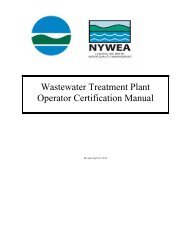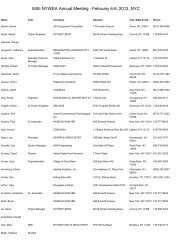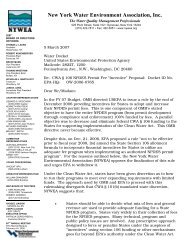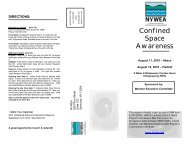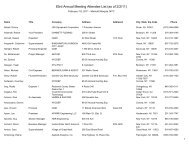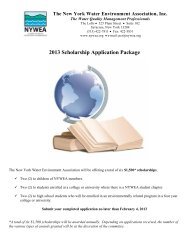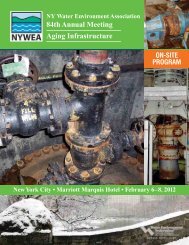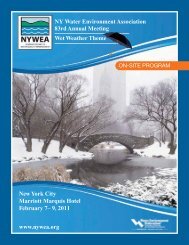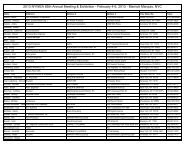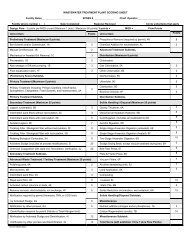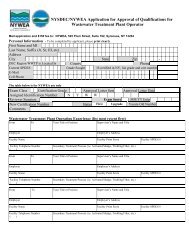Technical Overview Wastewater Effluent - NYWEA
Technical Overview Wastewater Effluent - NYWEA
Technical Overview Wastewater Effluent - NYWEA
Create successful ePaper yourself
Turn your PDF publications into a flip-book with our unique Google optimized e-Paper software.
13329112.5<br />
New York Water Environment Association, Inc.<br />
The Water Quality Management Professionals<br />
525 Plum Street, Suite 102 • Syracuse, New York 13204<br />
(315) 422-7811 • Fax: 422-3851 • www.nywea.org<br />
<strong>Overview</strong> and <strong>Technical</strong> Recommendations<br />
Concerning the Use of <strong>Wastewater</strong> <strong>Effluent</strong> for Hydrofracturing Make-Up Water<br />
I. Introduction to the Topic<br />
(May 16, 2011)<br />
The production of natural gas currently trapped within Marcellus Shale and deeper deposits in<br />
New York and elsewhere by hydrofracturing of the formation may become a significant activity in New<br />
York in the near future. Hydrofracturing (“fracking”) is a water intensive activity with the fracking of a<br />
single well potentially utilizing 5 million gallons of water or more. While in other states initially much,<br />
if not all, of this water came from potable water sources and/or from surface or groundwaters, continued<br />
use of such large volumes of potable water is not sustainable. Likewise, significant use of surface or<br />
groundwater as the primary source of frac water may cause potentially significant environmental or<br />
other impacts.<br />
The natural gas drilling industry has recognized these realities and is moving toward re-using<br />
most of the recovered frac water (termed “flowback” water). The New York Water Environment<br />
Association 1 (“<strong>NYWEA</strong>”) endorses the concept of recovery and re-use of frac water and encourages the<br />
natural gas development industry to continue to research and develop the knowledge and technologies<br />
needed to make re-use of significant quantities of flowback water a common practice. Recent articles<br />
and announcements by both governmental entities and the Marcellus Shale-related gas development<br />
industry indicate that this trend toward increasing re-use of fracking-related flowback water as makeup<br />
water for hydrofracturing is being given a high priority. The industry’s stated goal is 100% reuse of this<br />
water 2 .<br />
No matter how successful the natural gas development industry is in achieving this goal<br />
however, there will continue to be the need for fairly significant volumes of water to blend with the<br />
recovered flowback water. This is due both to the fact that a significant portion of frac water is not<br />
1 The New York Water Environment Association (<strong>NYWEA</strong>) is a statewide nonprofit organization of approximately 2,500<br />
water and wastewater professionals, environmental engineers and scientists, and water quality management<br />
professionals dedicated to protecting and enhancing the waters of New York. <strong>NYWEA</strong> is primarily an educational<br />
organization dedicated to educating not only our members but also those who are charged with setting policy and<br />
practices intended to protect the water environment here in New York.<br />
2 See, Sustainable Management of Flowback Water during Hydraulic Fracturing of Marcellus Shale for Natural Gas<br />
Production, DOE/NETL at http://www.netl.doe.gov/technologies/oilgas/Petroleum/projects/Environmental/Produced_Water/00975_MarcellusFlowback.html.
ecovered as flowback 3 and because recovered water, even if treated, will often have to be blended with<br />
cleaner water to make it suitable for re-use in fracking. 4<br />
NYSDEC 5 and others have indentified treated wastewater as a possible source of frac make-up<br />
water. Recent media reports 6 on two municipalities who are in discussion with natural gas drillers or<br />
development companies concerning selling their treated municipal wastewater effluent, illustrate that<br />
use of treated wastewater for this purpose could be a “win-win” situation for both the natural gas<br />
industry and municipalities or industries that must treat and dispose of their wastewater. For example,<br />
given that much of the New York Marcellus Shale area is located within the Chesapeake Bay watershed,<br />
up to 26 municipalities and a few industries will have to invest significant funds over the next 7 years in<br />
order to install and operate processes to reduce effluent concentrations of nitrogen and/or phosphorus<br />
pursuant to the recently finalized Chesapeake Bay TMDL (Total Maximum Daily Load). 7 To<br />
municipalities such as these, a new source of possible wastewater-related revenue is attractive. Another<br />
potential positive benefit of re-use of treated wastewater effluent for use in gas well development, is that<br />
using water from this source will reduce the need for water withdrawn from surface waters. In addition<br />
to the obvious benefits of reducing surface water withdrawals, is the fact that such reductions should<br />
also reduce the potential for gas well development water withdrawals and transport of this water to<br />
another location to increase the spread of aquatic invasive species.<br />
The purpose of this paper is to examine technical issues related to the possible re-use of treated<br />
wastewater as frac make-up water with respect to environmental and human health.<br />
This paper does not address issues related to the impact of fracking water on groundwater or on<br />
the treatment of flowback water by municipal wastewater treatment plants (“POTWs”). The former<br />
issue is too site-specific to be handled in a single paper, and treatment of flowback water by POTWs is<br />
the subject of a companion <strong>NYWEA</strong> white paper entitled Evaluating the Acceptability of Gas Well<br />
Development and Production-Related <strong>Wastewater</strong> at New York <strong>Wastewater</strong> Treatment Plants. This<br />
paper also does not address the issue of transporting treated effluent and safely storing it at a gas well<br />
development site prior to its use as a make-up water. This latter issue is addressed in the companion<br />
<strong>NYWEA</strong> White Paper entitled Protection of Surface Waters Associated with Shale Gas Drilling and<br />
Related Support Sites.<br />
3 Id. Recent estimates are that between 25 and 100% of frac water is recovered. However, not all flowback water will be<br />
suitable for re-use. See, Sustainable Management of Flowback Water during Hydraulic Fracturing of Marcellus Shale<br />
for Natural Gas Production, DOE/NETL at ml<br />
4 Id.<br />
5<br />
See, New York Draft Phase I Watershed Implementation Plan, Chesapeake Bay Nitrogen, Phosphorus and Sediment<br />
TMDL, NYSDEC, 9/1/2010 at §II(c) pg 28.<br />
6 Owego Puts Sale of <strong>Wastewater</strong> for Fracking on Hold Village will conduct environmental assessment before voting<br />
Broader View Weekly, (December 23, 2010) and Kane Borough Sewer Authority Making Money From Selling <strong>Effluent</strong><br />
To Marcellus Shale Driller March 2010. (http://www.tiogagaslease.org/images/BVW_12_23_10.pdf;<br />
http://marcellusdrilling.com/2010/03/kane-borough-sewer-authority-making-money-from-selling-effluent-to-marcellusshale-driller/)<br />
7 In October 2010, NYSDEC estimated that the cost of compliance for the 28 New York “Bay Significant” wastewater<br />
treatment plants (all but two of which are POTWs) would be ~ $140 Million if its plan for compliance were adopted. If<br />
federal “backstops” are imposed, the cost could be $1.0 to 1.5 billion. See,<br />
http://www.epa.gov/reg3wapd/pdf/pdf_chesbay/pubmtgagendas2010/NYDraftCBayPlan.pdf.<br />
13329112.5
II. Questions Evaluated<br />
13329112.5<br />
This paper focuses on whether there might be constituents in POTW effluent which would:<br />
1. make the effluent unsuitable for use as a frac water,<br />
2. pose a potentially significant incremental increase of risk to the environment, or<br />
3. present a health threat to those working (or living) near where POTW effluent is stored or<br />
used as frac make-up water.<br />
III. Assumptions<br />
The evaluation discussed in this paper is based on the following assumptions:<br />
1. Any New York POTW that would be considering providing its treated effluent as makeup<br />
water for hydrofracking has installed and is fully meeting at least secondary treatment standards.<br />
2. The regulatory process will be sufficiently robust to insure that during normal (noaccident)<br />
operations, frac water does not enter fresh groundwater and that enforceable regulations and<br />
permit conditions (such as casing requirements etc.) also minimize the potential for accidental releases<br />
to fresh groundwater and the unsaturated zones above fresh groundwater.<br />
IV. Results<br />
A. Quality of <strong>Wastewater</strong> Needed If Used for Hydrofracking<br />
<strong>NYWEA</strong> finds that most POTW or other treated wastewater which is being discharged to a<br />
Water of the State in compliance with a SPDES permit should be of acceptable quality to use as fracking<br />
make-up water. The basis of this conclusion is that permit limits and other requirements within the<br />
SPDES Permit must be based on the Clean Water Act (CWA)-mandated secondary treatment and<br />
minimum removal requirements for municipal wastewater. 8 For non- municipal wastewater effluents,<br />
such as those from industrial or commercial wastewater treatment facilities, numeric effluent limits and<br />
other requirements based on the CWA mandated “Best Conventional” or “Best Available” Treatment<br />
technology must be met. The existing CWA requirements may be even lower than these “technologybased”<br />
requirements, if necessitated by the water quality needs of the current receiving waters. The one<br />
exception to this, which is discussed in Section IV(C) below, is for effluent from those wastewater<br />
treatment plants whose current SPDES permit does not require disinfection.<br />
For the 26 POTWs within New York’s Southern Tier, and hence close to where hydrofracking<br />
may take place in the state, by 2025 (the end of the compliance period for the Chesapeake Bay TMDL<br />
imposed additional nutrient removal) the effluent will be of even higher quality by the time nitrogen<br />
and/or phosphorus removal capabilities are in place. Other POTWs with Water Quality-based effluent<br />
limits already incorporated into their SPDES permits will also have effluent quality that is better than<br />
8<br />
See, 40 CFR §133.102. Thirty day averages for BOD5 and TSS set at 30 mg/L with mandated 85% removal. Required<br />
effluent pH between 6 and 9.
13329112.5<br />
- 4 -<br />
secondary. Because the Marcellus Shale natural gas development industry is already using recovered<br />
frac water as make-up water, with its much lower water quality, use of cleaner wastewater treatment<br />
effluent should be acceptable to most of the industry.<br />
In addition to being of a quality which consistently meets its S/NPDES Permit requirements, the<br />
natural gas driller/development entity considering purchasing treated wastewater effluent may place<br />
additional quality-related requirements into its water purchase contract. Such additional requirements<br />
may reflect the needs of their hydrofracking solutions and/or requirements imposed through their state or<br />
local permits or approvals. To the extent reasonably practicable, these requirements should be identified<br />
as early in the discussion process as possible in order to allow any additional monitoring or other data<br />
collection related to the quality of the wastewater treatment effluent to be initiated.<br />
B. Environmental Protection<br />
Treated wastewater effluent, which is both of a quality to be useful as hydrofracking make-up<br />
water and which is free of potentially harmful levels of pathogenic organisms, must also not pose a<br />
potentially significant incremental increase of risk to the environment. In support of this goal <strong>NYWEA</strong><br />
assumes that the drilling of gas wells and the use of hydrofracking solutions will be adequately<br />
controlled through the natural gas drilling and recovery permitting and regulatory process. It notes that<br />
such things as required specifications for the use of multiple well casings and well joint cement<br />
requirements are pivotal in preventing the unintended injection of hydrofracking water into fresh<br />
groundwater and to the hydrogeologic layers above and immediately below all freshwater groundwater.<br />
Thus, <strong>NYWEA</strong> concludes that in most instances, the use of treated wastewater effluent which was<br />
previously consistently meeting its SPDES discharge requirements as hydrofracking make-up water<br />
should not add any incremental risk to fresh (Class GA) groundwater, as long as our stated assumption<br />
that the regulatory process will be sufficiently robust to insure that during normal (no-accident)<br />
operations, frac water does not enter fresh groundwater and that enforceable regulations and permit<br />
conditions (such as casing requirements etc.) also minimize the potential for accidental releases to fresh<br />
groundwater and the unsaturated zones above fresh groundwater is met.<br />
The management of treated wastewater effluent above ground, before it is used as hydrofracking<br />
make-up water, can pose an environmental threat if not done according to a well thought out and<br />
implemented Best Management Plan (BMP). <strong>NYWEA</strong> notes, however, that the same is true for<br />
virtually all of the above ground operations and practices at a natural gas well drilling (or support) site.<br />
Hence issues related to the appropriate management of these waters are addressed in the companion<br />
BMP-related <strong>NYWEA</strong> White Paper entitled Protection of Surface Waters Associated with Shale Gas<br />
Drilling and Related Support Sites.<br />
Further, the cessation of the current discharge of this treated wastewater effluent to surface or<br />
groundwaters may cause its own negative environmental impact if this discharge makes up a significant<br />
part of the stream flow, especially during critical low flow periods.<br />
C. Health and Safety of Workers and Others<br />
Treated wastewater, especially if it has not been disinfected, may contain bacteria and other<br />
organisms potentially harmful to human health. While most wastewater discharged to surface waters in<br />
New York are required to be disinfected by their SPDES permit, there are some SPDES permit
13329112.5<br />
- 5 -<br />
controlled effluents for which disinfection is not a current requirement. For example, some discharges<br />
to smaller “headwater” streams are not required to be disinfected because of a concern that the<br />
disinfectant might cause toxicity to sensitive fish or other aquatic species. 9<br />
In the event that wastewater from a wastewater treatment plant which is not currently being<br />
disinfected is being considered for use as hydrofracking make-up water, <strong>NYWEA</strong> believes that, in most<br />
cases, some type of disinfection will be a necessity. Further, while the mechanism to be used for<br />
disinfection should be a matter of negotiation between the wastewater treatment plant, the New York<br />
State Department of Environmental Conservation (or other involved regulatory agency) and the natural<br />
gas developer/driller, <strong>NYWEA</strong> recommends that serious consideration be given to the use of a nonoxidizing<br />
disinfection technique or chemical such as Ultraviolet or Ozonation if any of the treated<br />
effluent will continue to be periodically discharged to a low flow receiving water. This will avoid the<br />
formation of tri-halomethanes and other disinfection by-products in those receiving waters.<br />
In addition to disinfection, <strong>NYWEA</strong> also recommends that when treated effluent is to be used for<br />
hydrofracking make-up water, its use and safe handling be incorporated into the Employee Safety<br />
Training programs which it assumes will be on-going at each of these sites.<br />
V. Summary of Conclusions and Recommendations<br />
1. The existing quality of treated wastewater effluent which is currently consistently<br />
meeting its SPDES Permit requirements should be generally sufficient for use as hydrofracking make-up<br />
water. Caution will need to be exercised anytime unusual events (excess wet-weather received at the<br />
head end of a wastewater treatment plant, upsets within the wastewater treatment system etc.) yields a<br />
wastewater effluent that is outside of SPDES permit limits. Perhaps the best way to address this is to<br />
make sure the contractual agreements between the wastewater treatment plant and the pre-established<br />
“acceptable quality” parameter-specific specifications and narrative requirements address what types of<br />
atypical events will trigger a duty to notify the entity purchasing the treated effluent for use as fracking<br />
make-up water.<br />
2. Depending on the specifications for a safe and effective hydrofracking fluid, some<br />
additional analytical testing and/or treatment may be necessary. It is recommended that additional data<br />
needs be identified early in the discussion process between the treated wastewater effluent producer and<br />
the natural gas driller/developer.<br />
3. To protect the local environment, proper storage and management of treated wastewater<br />
effluent is necessary. The recommendations in the companion <strong>NYWEA</strong> White Paper entitled Protection<br />
of Surface Waters Associated with Shale Gas Drilling and Related Support Sites should be considered.<br />
These include, but are not limited to:<br />
New regulations, General Stormwater SPDES permit requirements and/or other<br />
enforceable requirements must account for the unique phasing and layout of shale gas<br />
9 Even for these discharges, disinfection is being added to many of these permits as a requirement as many of these<br />
SPDES permits are being renewed. The newer permits typically have stringent Chlorine/Total Oxidant limits which are<br />
met either by using a non-chemical means to disinfect (such as UV disinfection) or through the addition of dechlorination<br />
facilities.
13329112.5<br />
- 6 -<br />
operations. This may be best accomplished by establishing a new Sector within the New<br />
York Multi-Sector Industrial Stormwater SPDES Permit, with explicit requirements<br />
based on the needs and activities of each phase at the various site and support locations.<br />
Containment and reduction of potential contaminants at their source should be<br />
highlighted as an effective and inexpensive approach for reducing water contamination.<br />
Monitoring is necessary in order to evaluate the effectiveness of practices and<br />
regulations. It is important to monitor the right things at the right times, in the right<br />
locations. This is likely best done on a site-by site basis. In the event of a suspected spill<br />
or release, use of real-time screening instrumentation (such as Specific Conductivity as<br />
an indicator of Total Dissolved Solids) should not only be allowed but actually<br />
encouraged.<br />
4. To protect worker health and safety, all treated wastewater effluent should be disinfected<br />
prior to it being stored or used at a natural gas drilling/development site. While not a recommendation,<br />
consideration should be given to using a non-oxidant based disinfection method if new disinfection<br />
methods are needed and the effluent may be periodically discharged to a low-flow surface water.<br />
VI. Other References and Related Resources<br />
[The following information is provided as a resource, it does not indicate a <strong>NYWEA</strong> position on these<br />
proposed DRBC regulations.]<br />
The Delaware River Basin Commission (DRBC) has proposed rules (and apparently has existing<br />
rules) giving it approval authority over all make-up water, included treated effluent. 10 Under the<br />
proposed rules, if a wastewater has already been approved for discharge into the DRB, then its approval<br />
for use as Frac make-up water may be eligible for an “Approval by Rule” (ABR) determination. 11 .<br />
Any additional permits required by the host State and/or the DRBC must be obtained before the<br />
wastewater can be re-used. <strong>Wastewater</strong> which is typically discharged within the DRBC can not (under<br />
the proposed rules) be diverted for natural gas drilling related use without DRBC approval.<br />
10 See, proposed Section 7.4 and Article 2 Section 2.3 of the DRBC Water Code.<br />
11 See proposed 7.4(d)(2)


